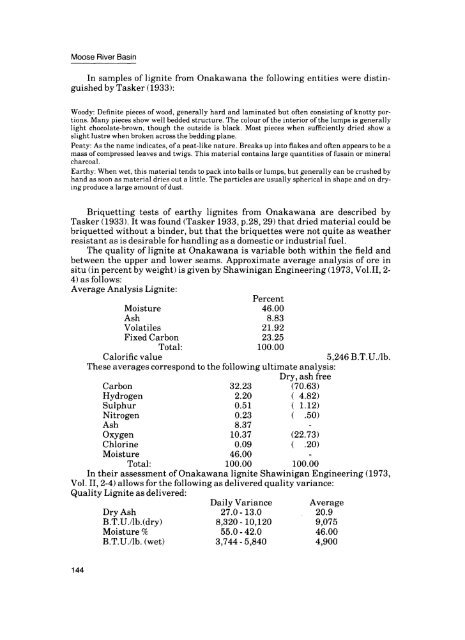Moose River Basin: geology and mineral potential - Geology Ontario
Moose River Basin: geology and mineral potential - Geology Ontario
Moose River Basin: geology and mineral potential - Geology Ontario
You also want an ePaper? Increase the reach of your titles
YUMPU automatically turns print PDFs into web optimized ePapers that Google loves.
<strong>Moose</strong> <strong>River</strong> <strong>Basin</strong><br />
In samples of lignite from Onakawana the following entities were distin<br />
guished by Tasker (1933):<br />
Woody: Definite pieces of wood, generally hard <strong>and</strong> laminated but often consisting of knotty por<br />
tions. Many pieces show well bedded structure. The colour of the interior of the lumps is generally<br />
light chocolate-brown, though the outside is black. Most pieces when sufficiently dried show a<br />
slight lustre when broken across the bedding plane.<br />
Peaty: As the name indicates, of a peat-like nature. Breaks up into flakes <strong>and</strong> often appears to be a<br />
mass of compressed leaves <strong>and</strong> twigs. This material contains large quantities of fusain or <strong>mineral</strong><br />
charcoal.<br />
Earthy: When wet, this material tends to pack into balls or lumps, but generally can be crushed by<br />
h<strong>and</strong> as soon as material dries out a little. The particles are usually spherical in shape <strong>and</strong> on dry<br />
ing produce a large amount of dust.<br />
Briquetting tests of earthy lignites from Onakawana are described by<br />
Tasker (1933). It was found (Tasker 1933, p.28, 29) that dried material could be<br />
briquetted without a binder, but that the briquettes were not quite as weather<br />
resistant as is desirable for h<strong>and</strong>ling as a domestic or industrial fuel.<br />
The quality of lignite at Onakawana is variable both within the field <strong>and</strong><br />
between the upper <strong>and</strong> lower seams. Approximate average analysis of ore in<br />
situ (in percent by weight) is given by Shawinigan Engineering (1973, Vol.11, 2-<br />
4) as follows:<br />
Average Analysis Lignite:<br />
Percent<br />
Moisture 46.00<br />
Ash 8.83<br />
Volatiles 21.92<br />
Fixed Carbon 23.25<br />
Total: 100.00<br />
Calorific value<br />
5,246 B.T.U./lb.<br />
These averages correspond to the following ultimate analysis:<br />
Dry, ash free<br />
Carbon 32.23 (70.63)<br />
Hydrogen 2.20 ( 4.82)<br />
Sulphur 0.51 ( 1.12)<br />
Nitrogen 0.23 ( .50)<br />
Ash 8.37<br />
Oxygen 10.37 (22.73)<br />
Chlorine 0.09 ( .20)<br />
Moisture 46.00<br />
Total: 100.00 100.00<br />
In their assessment of Onakawana lignite Shawinigan Engineering (1973,<br />
Vol. II, 2-4) allows for the following as delivered quality variance:<br />
Quality Lignite as delivered:<br />
Daily Variance Average<br />
Dry Ash 27.0-13.0 20.9<br />
B.T.U./lbXdry) 8,320 -10,120 9,075<br />
Moisture 7c 55.0 - 42.0 46.00<br />
B.T.U./lb. (wet) 3,744-5,840 4,900<br />
144

















